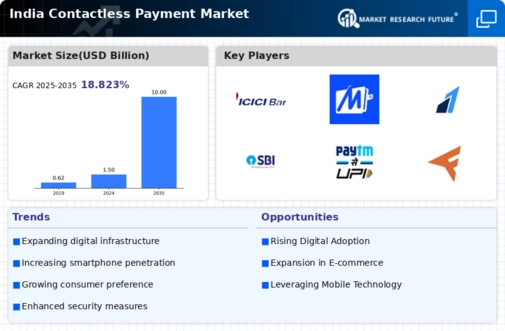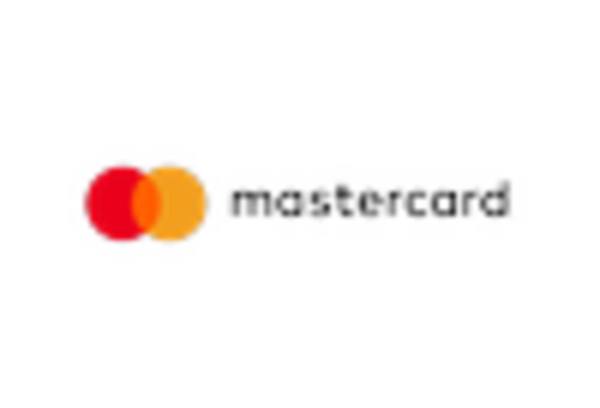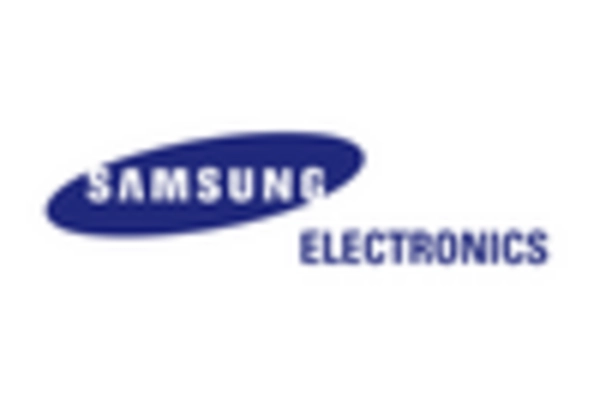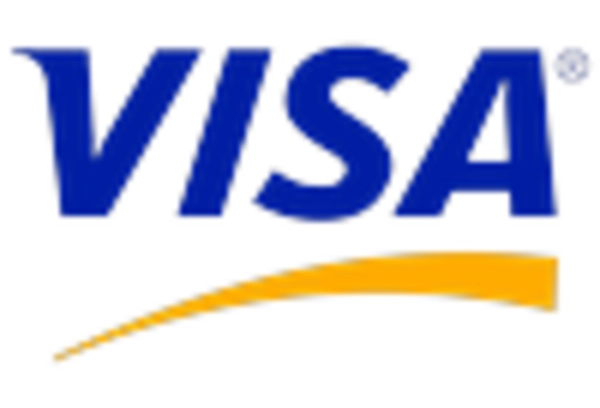The contactless payment market in India is characterized by a rapidly evolving competitive landscape, driven by technological advancements and changing consumer preferences. Major players such as Visa Inc (US), Mastercard Inc (US), and American Express Co (US) are at the forefront, focusing on innovation and strategic partnerships to enhance their service offerings. Visa Inc (US) has been particularly active in expanding its digital payment solutions, aiming to integrate more seamlessly with mobile wallets and e-commerce platforms. Meanwhile, Mastercard Inc (US) emphasizes its commitment to security and fraud prevention, which is crucial in building consumer trust in contactless transactions. These strategies collectively foster a competitive environment that prioritizes technological integration and consumer-centric solutions.
In terms of business tactics, companies are increasingly localizing their operations to better cater to the Indian market. This includes optimizing supply chains and establishing partnerships with local fintech firms to enhance service delivery. The market structure appears moderately fragmented, with several key players vying for market share, yet the influence of major corporations remains substantial. Their collective efforts in innovation and localized strategies are reshaping the competitive dynamics, making it imperative for smaller players to adapt quickly.
In October 2025, Visa Inc (US) announced a partnership with a leading Indian fintech startup to enhance its contactless payment infrastructure. This collaboration aims to leverage the startup's technological expertise to improve transaction speeds and security features, indicating Visa's strategic focus on enhancing user experience and operational efficiency. Such partnerships are likely to bolster Visa's market position by integrating cutting-edge technology into its existing framework.
In September 2025, Mastercard Inc (US) launched a new initiative aimed at promoting financial literacy among small merchants in India. This program is designed to educate merchants on the benefits of contactless payments, thereby driving adoption rates. The initiative underscores Mastercard's strategy to not only expand its user base but also empower local businesses, which could lead to increased transaction volumes and a stronger market presence.
In August 2025, American Express Co (US) introduced a new rewards program specifically tailored for contactless transactions in India. This program incentivizes users to adopt contactless payments by offering exclusive benefits, which may enhance customer loyalty and drive higher transaction frequencies. Such strategic moves reflect a broader trend of companies seeking to differentiate themselves through value-added services rather than competing solely on price.
As of November 2025, the competitive trends in the contactless payment market are increasingly defined by digitalization, sustainability, and the integration of artificial intelligence. Strategic alliances are becoming more prevalent, as companies recognize the need to collaborate to enhance their technological capabilities and market reach. Looking ahead, competitive differentiation is likely to evolve, with a shift from price-based competition to a focus on innovation, technology, and supply chain reliability. This transition suggests that companies that prioritize these aspects will be better positioned to thrive in an increasingly competitive landscape.

















Leave a Comment